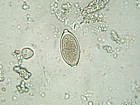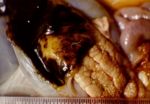Trichuris
| This article is still under construction. |
| Also known as: | whipworm |
Overview
The Trichuris worms are so called due to their characteristic whipe like structure. They have a broad posterior end tapering to a long and narrow neck which is inserted into the caecal mucosa. They have a direct life cycle, moving directly into the definitive host from the infective L1 egg stage. Once ingested the larva is freed from the egg casing and forms a mucosal nodule in which to develop before emreging into the lumen of the gastointestinal system.
Characteristics
Eggs The eggs of Trichuris species are brown in colour and are bioperculated (have a plug in each end). They are hardy eggs and in the correct coonditions can survive on pasture for up to 12 years. The Trichuris embryo develops inside the egg and is infective as the 1st larval stage living within the egg. Larvae Hatch from the egg into the small intestine and there grow and moult until the reach adulthood. Adult Attach to the mucosa of the large intesitine.
Life Cycle
The life cycle is not a standard nematode life cycle as these species are infective within the egg at a very early stage of embryo development. This means infective eggs can be present on pasture within 10 - 14 days of adult patency. Eggs are transerred to pasture in the feaces of the host animal and then ingested by animals grazing on the pasture; feaco-oral spread. Thrichuris spp. have no tissue migratory period, living there entire lives in the small and large intestine of the host.
Important Species
There are several species of veterinary importance, each typically infecting a different host species;
- Trichuris vulpis; the dog whipworm
- Trichuris campanula (Europe) and Trichuris serrata (North America); cat whipworms, though these are only seen rarely.
- Trichuris suis; the pig whipworm
Clinical
- Adult buries its thin anterior half into the intestinal mucosa and feeds on tissue secretions (not blood).
- The caecum and colon are the most commonly infected sites.
- Causes eosinophilia.
- Signs may include:
- Diarrhoea
- Anemia
- Dehydration


